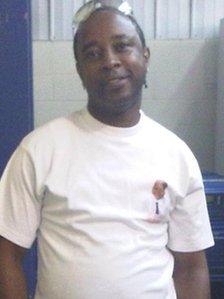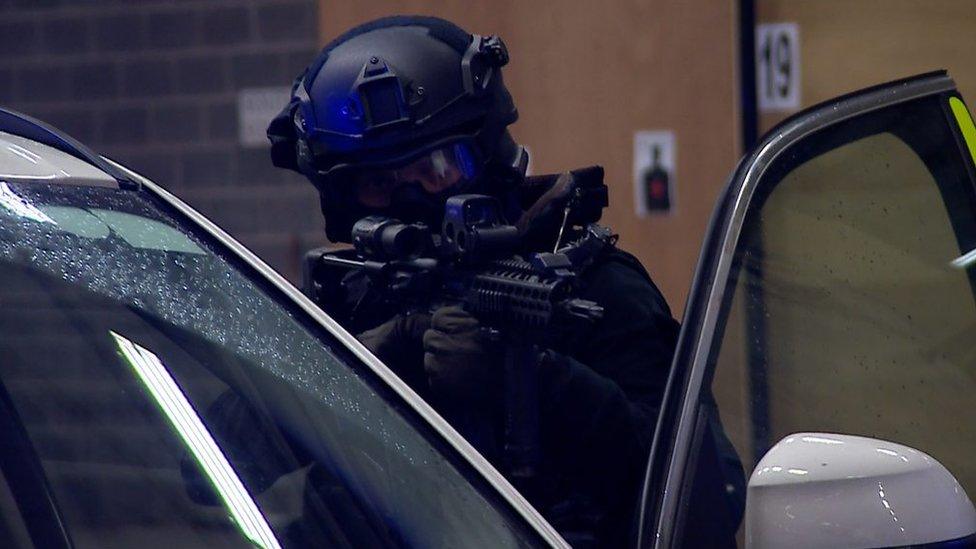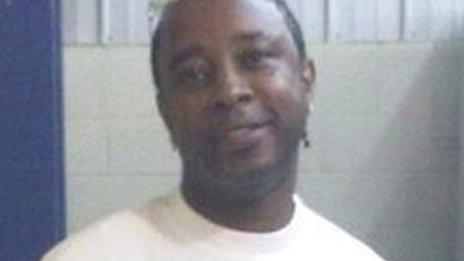Gun crime highest for a decade for four police forces
- Published
The number of firearms officers has declined in the past decade
Gun crime in four English counties was at its highest for a decade in 2017-18.
West Yorkshire, Bedfordshire, Cambridgeshire and Cheshire police handled more incidents than in any year since 2007-08.
Overall gun crime in England and Wales is lower than 10 years ago, the Office for National Statistics (ONS) said, external.
More than one in five victims of firearms offences, excluding air weapons, was aged under 20.
Police believe that firearms crimes in some areas are linked to "county lines", where gangs move drug-dealing operations outside big cities to smaller towns.
The figures, released on Thursday, come alongside statistics showing fatal stabbings at their highest level since records began in 1946.
The ONS analysis for individual police forces covers the year to the end of March 2018 and showed 6,521 firearms offences, a 2% rise and the fourth increase in a row.
However, previously released national figures for England and Wales, external showed a decrease in firearm offences in the year to September 2018, although these are not broken down by individual force.
The ONS said levels of firearm offences are "41% lower than their peak in the year ending March 2006" when there were 11,088 offences.

West Yorkshire Police dealt with 481 incidents of firearms offences, a rise of 10% on the previous year and more than double the figure recorded four years earlier.
Bedfordshire Police handled 106 incidents and Cambridgeshire recorded 84.
Cheshire recorded 81 offences, a rise of 14% on the previous year.
West Yorkshire Police Assistant Chief Constable Tim Kingsman said: "We've seen a rise in the availability of firearms for use by criminals."
He said police went on 896 firearms operations in 2018, equivalent to two or three a day.

In Wiltshire the number of firearms offences, excluding air weapons, increased almost fourfold in one year.
There were 39 firearms offences in 2017-18, up from 10 in 2016-17, but lower than 2007-08 when there were 49 offences.
Wiltshire Assistant Chief Constable Gavin Williams said: "It is important to keep these figures in context - we still have one of the lowest number of firearms offences in the country.
"Incidents of firearms out in our communities are very rare - these are often linked to other offences such as county line drug gangs."
Cambridgeshire Police said in a statement: "Firearms offences tend to be linked to organised crime groups and will not be tolerated in Cambridgeshire.
"We are reviewing this data to understand the increase, which equates to 22 offences and the total number remains well below the national average."
Det Ch Insp Duncan Young of Bedfordshire Police said tackling violent crime, including the use of firearms, was a "key priority".
"We recognise that this is understandably a cause for concern for our communities, and we would like to reassure them that we are working hard to combat gun crime and rid our county of dangerous weapons."

'A gun tore us apart as a family'

Paul Foster died in hospital in April 2013
Paul Foster died after being shot in chest in what police believe was a case of mistaken identity.
Almost six years on, his wife Amanda, a mother of four from Luton, said the pain of loss was something she felt every day.
Mr Foster, also known as Big Shyne, was shot on the Lewsey Farm estate on 9 April 2013.
"It has torn us apart as individuals and as a family," Mrs Foster said.
She said she was "shocked, but not shocked" by recent rises in gun crime in Bedfordshire.
"Whether it is guns or knives, young people have somehow decided that using a weapon is cool, and obviously it is not," she said.

Norfolk, Suffolk saw gun offences drop more than 50% in a year, along with Dyfed-Powys.
Three regions - the South West, North West and West Midlands - recorded an overall rise.

The Home Office said it had provided £144m for armed policing.
- Published28 January 2019

- Published9 April 2014

- Published9 October 2013
